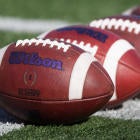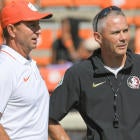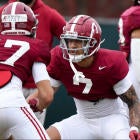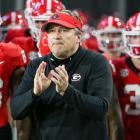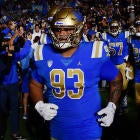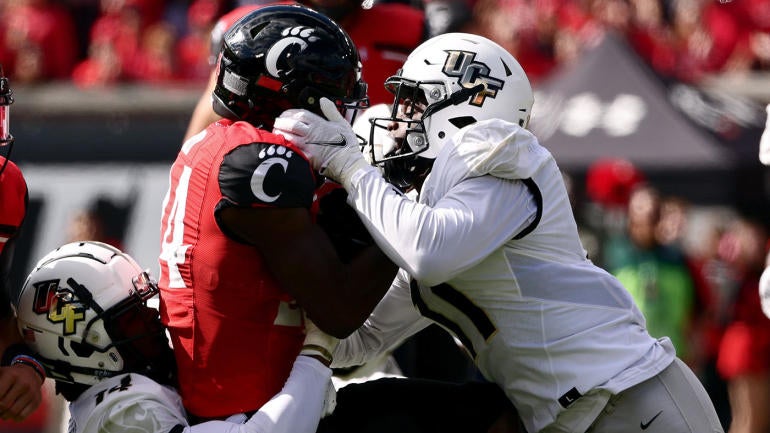
Few programs know the feeling of being left out of the big leagues quite like Houston. In 1994, four schools left the Southwest Conference to create the Big 12, leaving the Cougars, SMU, TCU and Rice wandering the non-power leagues as various in-state brethren competed on the national stage.
"There are a lot of people that have a lot of scars from when the Southwest Conference broke up and we got left out," Houston athletic director Chris Pezman told CBS Sports. "There are a lot of people who have a massive chip on their shoulder."
After 25 years of waiting, everything is about to change as Houston is one of four programs bound for the Big 12 ahead of the 2023 college football season. Cincinnati and UCF join the Cougars from the AAC, while BYU ends its decade-long run as an independent to join a major football conference for the first time.
On July 1, the "Freshman Four" step into the brave new world of Power Five college athletics, the first to join the top half of college football's top division since Rutgers moved from the AAC to the Big Ten in 2014. But with a fancy new logo on the jerseys comes big money, resources and prestige that all four schools are hoping can set themselves up for the murky future of college football.
"Financially, it means a lot. Recruiting, it means a lot to be able to tell recruits that you're going to play at the highest level," Cincinnati AD John Cunningham said. "Institutionally, there's been so much investment over the last 10-20 years to get to this point."
TV revenue is king
Houston football has undergone a resurgence in recent years since joining the AAC, winning at least 10 games under four different coaches since 2005 and relishing a Peach Bowl victory over Florida State in 2015. The basketball program has grown into one of the nation's best under legendary coach Kelvin Sampson. Behind the scenes, however, athletics has been over-leveraging its budget to create this opportunity.
Houston's athletic expenses rose nearly 63% between 2014-22, according to inflation-adjusted data from the Knight-Newhouse College Athletics Database. Football spending alone rose 67% prior to the pandemic, which still wasn't enough to bring Houston above the FBS median.
School filings obtained by the College Athletics Database show that more than 50% of Houston's revenue in 2022 came via institutional and government support, but only 12% came from conference distribution. For comparison: Nearly 40% of Texas Tech's revenues in the same year came from conference distribution with only 5% coming from institutional and government support.
"It sounds really hokey and really kind of basic and obvious, but at the same time, it's been this cloud that's hung over us," Pezman said. "Any time we needed to do something extra, whether keep Kelvin Sampson or hire Dana Holgorsen, we were extending ourselves financially even further into the hole. We were doing it in the hopes that we would have a chance to make this transition. And now that it's coming together, we're seeing the ways that the finances start to work for an athletic department to be self-sustaining."
Television revenue makes up the largest portion of conference distribution for nearly every FBS league. The AAC's deal with ESPN in 2019 doles out approximately $7 million in television distribution per team, while the Big 12's new contract will exceed $31 million per institution with annual payouts that could exceed $50 million with the arrival of the expanded College Football Playoff in 2024.
Though payouts take center stage, funding around the edges is really where departments make their hay. Selling a Power Five product can quickly increase donor engagement and corporate partnerships. In the six weeks after Houston announced its 2023 schedule, headlined by a marquee matchup against hated Texas, 5,000 new season tickets have been sold; that essentially gets the Coogs to their sales budget for the fall three months before games start. The highly ranked basketball program is examining ticket price raises in the 40% range, which would just get them to the upper half of the Big 12's pricing.
In Orlando, Florida, UCF quickly signed long-term naming rights agreements for both its football and basketball arenas after announcing the Big 12 jump. In 2013, Addition Financial Credit Union paid UCF approximately $560,000 per year for naming rights to Addition Financial Arena. After the move, AFCU agreed to a 12-year contract that will pay the school more than $1.6 million per season, nearly tripling the previous investment.
"I truly believe these are all a direct result of our invitation to the Big 12 ... it's a sense of pride," UCF AD Terry Mohajir said. "It's made Orlando a Power Five city. As the hometown university, we now have a Power Five program right in the heart of Florida and right in Orlando."
BYU previously signed a contract with the Independence Bowl for 2023 and 2025, but the annual postseason game has now been folded into the Big 12's pecking order, giving the Cougars far more access to marquee destinations. Additionally, a Big 12 schedule sends the institution affiliated with the The Church of Jesus Christ of Latter-day Saints to three of the eight most populated Mormon states in the nation.
New members of the Big 12 will not receive full distribution during their first few years in the league. Still, even a piece is significant enough to make a difference.
"What's so cool about it is your conference distribution, it's kind of like your entry, it's like an interest payment," Pezman said. "It's there every year, and it's going to continue to grow, and that's what you build everything off of. But the increase in ticket sales, donations, multimedia rights, all those other things are going to be [significantly more] on top of the conference distribution."
How money is being spent
Mohajir quickly got to work putting together a public plan for the athletic department in anticipation of Big 12 competition, identifying four priorities detailed at a school-run website called Mission XII: facilities, personnel, operating budgets and name, image and likeness (NIL).
"The money goes pretty quickly when you start looking at what you're trying to do to enhance your four parallel tracks," Mohajir explained.
Easily the most visible expense has been facilities. All of the "Freshman Four" underwent massive football operations investments, creating bigger areas for both players and coaches. The facilities are standard among Big 12 schools. Cincinnati is building an 84,000 square foot indoor practice facility and a 96,000 square foot performance center, both of which will be ready by 2025.
In addition to football upgrades, UCF is quickly getting its basketball facilities up to snuff before joining college hoops' premier league. Elsewhere, the men's and women's locker rooms are being revamped, and new turf was installed for the baseball and softball fields. Developments for tennis, golf and track are coming soon.
Salaries are another significant expenditure. The costs are obvious: Power Five coaches are typically paid substantially higher than those in the Group of Five. Gus Malzahn's $2.3 million contract at UCF was average among AAC coaches, but now, he ranks as the lowest-paid coach in the Big 12 (that number is somewhat offset by a $21.45 million buyout tied to his dismissal from Auburn).
Assistant coaching salaries also increase quickly, but the real difference comes downwind. Group of Five schools typically operate on a shoestring budget for support staff, whereas Power Five programs often amass armies of film analysts and recruiting staffers. Increasing the investment for staff roles can more effectively tailor player and recruiting efforts.
Student experience expenses can also add up quickly. Within the last 18 months, Cincinnati hired its first director of performance nutrition and its first director of sports psychology to address nutrition and mental health concerns. As part of renovations, BYU remodeled the Built4Life Center, which holds tutoring and advisory sessions for athletes.
"When I was at App State, you know you're going to lose coaches year-in and year-out because you just can't pay them," Cincinnati coach Scott Satterfield said. "Another difference is recruiting budget, what you're able to spend on resources to go out recruiting and also on-campus recruiting. One of the things you can do is when groups come on campus, some of these schools, they'll lay out the red carpet. If you don't have the money, you can't do that.
"Can you still win? Yes, you can still win," he continued. "But all those things help."
Acquiring blue-chip talent
For Top247 wide receiver Mikal Harrison-Pilot, Houston's move came at the perfect time. The son of former Cougars defender Chris Pilot quickly emerged as a major national recruit with offers from a number of the nation's best programs. Harrison-Pilot visited Houston's campus for the first time in 2018, and the Coogs were the third FBS team to offer him (within a week of Baylor and Oregon State). Holgorsen and his staff quickly made Harrison-Pilot a priority, even when it seemed like Houston was not a serious contender.
Momentum shifted with the Big 12 announcement.
"That's only a one-time thing, being part of that '23 class to bring Houston into the Big 12," Harrison-Pilot said. "My name is a part of that team. It's a goal you can cross off for any recruit just being in a new class, being in a new conference ... the Big 12's the second-best conference, and they're going to get me ready for the next level."
Harrison-Pilot rated as the fourth-best recruit in program history when he signed, signaling a significant shift in fortunes. Fellow 2023 WR Jonah Wilson is the sixth-best, and fifth goes to 2022 recruit Matthew Golden, who also joined the program after the Big 12 announcement.
That trend carries across the new Big 12 programs. UCF signed defensive lineman John Walker as its first top-100 national recruit in the 2023. Linebacker Andrew Harris and EDGE rusher Isaiah Nixon also rank among the top six players to sign with the Knights. BYU responded with a top-25 transfer class, headlined by former Pitt and USC quarterback Kedon Slovis. Despite a coaching change, Cincinnati landed the second-best quarterback recruit in program history: Brady Drogosh of Warren (Michigan) De La Salle.
The three former AAC schools signed a combined seven blue-chip recruits; the 12 remaining AAC schools signed just two.
Over the past five high school recruiting cycles, the eight continuing Big 12 schools had a median national class rank of 44.2, per 247Sports. The seven continuing members of the AAC sat at No. 80. Outside of Kansas, which only recently pushed its way out of the Big 12's basement, only one Big 12 recruiting class ranked lower than No. 64. Memphis was the only school with more than one class better than No. 64 in the AAC. The trend stratifies across Group of Five conferences, too, with the AAC far outpacing the Sun Belt's 101.8 median.
"[The city of] Houston has a lot of great players, but they weren't coming because people didn't want to play in the conference they were in last year," Harrison-Pilot said. "The Big 12 plays a major role recruiting-wise. Everyone is pumped up trying to get new, better things."
Redefining what 'Power Five' means
In October 2022, the Big 12 beat other conferences to market by locking an extension with Fox and ESPN to broadcast games through 2031. The contract gave the conference much-needed stability in the wake of Texas and Oklahoma's departure for the SEC.
However, while Harrison-Pilot considers the Big 12 one of the two top conferences in college football, the FBS will soon have to contend with behemoth television contracts from the Big Ten and SEC. The gap between the Top Two and Middle Three could soon clear $20 million per year and create a new round of headaches.
The issues are not the Big 12's alone. Seven ACC schools have expressed concern about the league's somewhat limited television contract that runs through 2036. The Pac-12 is still in the midst of a tense negotiation for a new television contract with the previous deal set to expire in 2024. No end date is in sight.
The "Freshman Four" have not been strangers to the dynamics. Even after the Big 12 announcement, Cincinnati lost highly successful coach Luke Fickell, who will nearly double his salary to just under $8 million at Wisconsin. Only one continuing Big 12 coach at a public institution earns more than $5 million a season: Oklahoma State's Mike Gundy. Salaries at Baylor, TCU and BYU are unavailable since private schools are not subject to public records requests.
Still, Cincinnati hired a sitting Power Five coach. Satterfield agreed to leave Louisville for the Bearcats, and the Cardinals were free to pursue their favorite son, Jeff Brohm from Purdue; the separation ultimately worked out for everyone.
"The fact that they were going into the Big 12 was a huge, huge selling point for me," Satterfield said. "I was sitting there in the ACC, playing some big-time ball in a big-time conference. The opportunity now to go play in another Power Five conference at a place where I felt administration -- at the highest level on campus and within the athletic department -- was much more stable. That was very, very important for me."
Despite the monetary dynamics, the continuing Big 12 remains optimistic about its positioning in the new world. The expanded College Football Playoff should help assuage concerns. The league will have at least six years of rock-solid membership during the expanded field, which guarantees six conference champions a spot in the field. There is no better example than TCU, which rose from the Mountain West to the CFP National Championship in the span of a decade.
Satterfield noted that during his shift from the ACC to the Big 12, there have been very few concerns about the conference's stature heading forward from recruits and parents.
"Obviously, the dollars are always important, but it's just as important the exposure that you get," Cunningham said. "When you're on Fox and when you're on ESPN, you're in every bar in every restaurant in the country all the time ... and there's some strategy behind that shorter-term contract because we know we'll have an opportunity to go back out and do another deal after that. To get the deal done and to quickly get the deal done has put us in an absolute prime spot in my mind."
For Pezman, getting to this point is worth it. He played for Houston during Andre Ware's Heisman Trophy run and starred four seasons in the Southwest Conference. In his mind, Houston belongs in the Big 12 with its Texan peers. The problems facing college football are new ones to take in stride, just like every other one the Cougars had to overcome for the last 25 years to return to the biggest stage in college sports.
"That's the good pressure; I'll take this all day long," Pezman said. "These are high-rent problems, and they're really not problems. I don't want to sound like a car salesman, but we asked for it. This is what we wanted. We're going to find a way to make this work and make the most of it."













